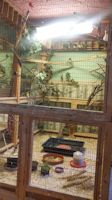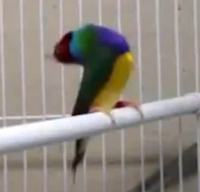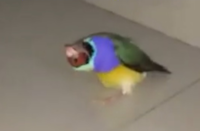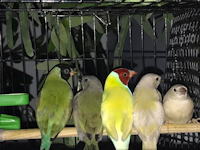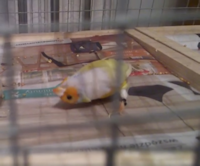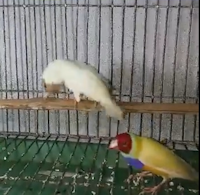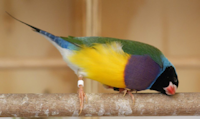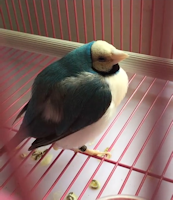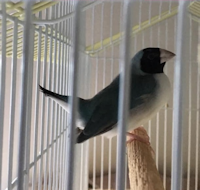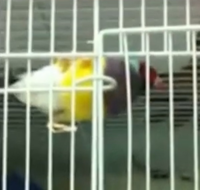Behaviour
Introduction
Just as you and I have our own distinct personalities, gouldian finches to have theirs. Despite some gouldian finches having similar appearances, never have I seen two sharing the same personalities. Of course personality will affect behaviour and once you get to know your birds' personality you will understand its behaviour much easier which I guess makes perfect sense. Each one will have a like and dislike of its own, but some people believe what one gouldian likes then they all do, how wrong they are.
The males have their own individual songs and their voices sound slightly different to other males. Although females do not sing, they do make sounds, many of these sounds are which all of them make but also have their individual sounds. They have their own pitch and voice pattern, and it is unique to each bird and I believe this is important when raising offspring, so the young can identify other birds from their parents. The songs of the males are generally complex and very quiet (depending on the time of year) and they will learn parts of songs from other birds including other species to add to their own songs. I once had a male gouldian finch which when young mimicked my male Cuban finch, the songs were identical even in pitch, volume and length, he's learnt the whole song which I found interesting. Sadly, when I was selling my one-year-old gouldian finches which were bred the year before, he was sold with them by mistake and was never seen again. A valuable tip, after six months or more when you remove the juveniles, make sure you have taken out only the juveniles and not your breeding stock.
I performed a very interesting social experiment with my gouldian finch flock, which proved a fact that they can identify one human from another. My gouldian finches some of which are hand reared are all kept in a large aviary and in the same room that I live, I used my brother and some friends to perform this experiment. I knew that when ever I stood by my aviary the gouldian finches would come close to the wires as if to greet me, so first I had a friend enter the room on his own and stood by the aviary, but none would come close. I used another friend wearing similar clothes and stood by the aviary whilst being the only one in the room, the birds were not interested at all. My brother who looks just like myself and wearing similar clothes stood by the aviary, the birds came up to the wires, but all moved away quickly when he spoke. Eventually I came in to the room alone and stood by the aviary then spoke, most of the usual birds gathered and would not move away. I repeated this test and got the same results every time, and realized they do know me by my face and voice. When ever a stranger comes in to the room, there is always panic or excitement in the aviary, which I found interesting.
With the gouldian finch, head colours mean everything and from many years of close observation I realized the black headed gouldian are the least aggressive, the red head is quite feisty and prefer to be higher up in the cage whereas the yellow headed gouldian finches like to be first in the pecking order. I have had more trouble with yellow headed gouldian finches than any other head coloured gouldian finch, especially during breeding season. During their breeding season, I always remove the yellow headed gouldian finches and put them all in a large flight of their own together, It gives the other gouldian finches an easier time. It makes perfect sense to separate them all by head colour anyway because during natural selection the hens will usually choose a mate having the same head colour as themselves. Mixing head colours at breeding times is almost like trying to breed different species of finches, and the hens seem to know this. If you breed two different head colours together the hens start laying less eggs, or produce mostly male offspring and on top of that many of the chicks struggle to survive. Their personalities do seem to match their head colours by way of aggressive to least aggressive. Some experiments performed by other groups have suggested the red head is the most dominant of all head colours, but I have found this not to be so.
After their breeding season has ended things slow down, singing from the males become much quieter and less frequent and there is much less aggression in the aviary. I always leave the juveniles with the parents until their annual moult, so they can learn their social skills, feeding habits etc. Without their parents, I believe they will become bad parents themselves, so they need to stay with the adults to learn their social skills and learn about parenting. I have seen people sell juveniles after only a few weeks of them leaving their nests, many of these usually die, become bad parents or have other problems. Like any human child, without other adults, they grow up to have many social issues. Juveniles should never be sold or given away until the following year, just after their first annual moult. Never buy any bird before its first annual moult or during its annual moult, it is the most stressful time for the bird, and it is when they are at their weakest.
To help the mood of your gouldian finches try to provide privacy/anti-stress perches, these perches are usually wide enough for just one gouldian to sit alone with sides that block other birds from seeing or being near them. These perches are useful for large aviaries or when they have chicks that will not leave the parents alone or other birds that pester them. Although gouldian finches like to be in a flock, they do however like time alone for periods to relax. An over stocked aviary where too many birds are crammed in will totally change the mood of all of your birds and will cause high levels of stress, they do not thrive in stressed conditions and will open the doors to undesired illnesses. You may witness chasing each other about within the aviary, but this does not always mean they are fighting and could signify playfulness, choosing a mate or a pecking order.
I often see hens who were once at war with each other during breeding season to be sitting next to each other quite happily for long periods of time when breeding season has ended. They usually have little energy left to waste on pointless fighting because they have achieved what they wanted, which was to breed, thus having no nest worth protecting any more. The gouldian finch will fight to the death over a nesting site or to protect their nest and can show some concerning signs of aggression when the conditions are right, but once breeding is all over can be the most placid bird in the aviary. This is why some people prefer to put pairs in smaller breeding cages to avoid the stress and hope for better results, whilst others prefer to let them breed in colonies where tensions can run high. I do both depending on the birds I have chosen based on their characters.
After a long stressful breeding season you may begin to see one or more birds sitting quietly alone fluffed up or looking much larger than normal, these birds should be carefully examined. If an illness is suspected then remove and place the bird in a hospital cage where it can receive heat from a lamp or heating device then closely observed. Any birds suspected of being ill should be removed swiftly to avoid the spread to healthy birds. Juveniles are usually the ones you need to watch the most as some become ill for various reasons but with acting fast with swift treatment they normally bounce back, but it is all about timing because you need to act as fast as possible. Those juveniles with parents who have different head colours seem to be the most at risk from the going light syndrome from my experience. Adults need to be watched, especially if they have raised a large clutch of chicks or have bred too many times within that year.
A month or two after their season is over you may notice the adult plumage has begun to look less vibrant, less tidy and some may exhibit baldness. It is usually the hens which exhibit baldness and not so much the males, the reasons for baldness can be genetic, mites, nutrition and stress related. Their feathers usually grow back after their next annual moult, and any sign of baldness usually disappears. When their moult begins make a note of all the birds and jot down which birds moult and when also their finish date. If after the annual moult there are still birds showing signs of baldness, then refer to the notes to make sure that bird actually went through its annual moult and completed the cycle. There are various types of moult, which are explained in the full software version. Their moulting cycle will greatly affect their moods and behaviour, making them more irritable, less social and less active, some to the point where they are unable to fly properly if at all. I find when in the moult they prefer to be alone a lot more than usual and aggression levels are at its lowest.
They should have access to fresh bathing water every day, meaning the water needs changing daily and bath cleaned properly. In the winter time they will usually bath less than in warmer weather but will still bath every day, whereas when it is summer they can bathe many times during the day. The bathing not only helps keep them clean, but also helps them keep cool when the weather is hot. Bathing will also encourage preening, during preening they stimulate the preening gland which in turn produces an oil, when that oil is exposed to direct sunlight(UV rays) it is converted into active vitamin D3 which can be ingested. The bird will rub this oil over every part of its body it can reach (including feathers) thus making more body coverage for collecting the precious vitamin D3. Although you can buy supplemental vitamin D3 for those birds who have no access to direct sunlight, it is not as good as the real thing, natural sunlight is always best.
After all the years of closely watching the gouldian finch species, I have noticed that their tails play an important part in their communication with one another. During mating rituals, you will notice their tails will point towards one another to show they are interested in each other. I have also witnessed a male flying on to a perch where another male is already perched then pointing his tail towards the perched male, and it appears as a friendly gesture. I have also seen this with hens, but never I have I seen any aggression linked to this tail pointing from either male or female. They seem to point their tails at each other when they have an interest in each other, to greet each other or when they are interested in something such as their favourite food, bath or nesting box. When the tail points upwards I have noticed it was usually to chase another bird away, when they are stressed or angry and other times when there are general health problems. I have really only witnessed the males pointing their tails directly downwards, and this is usually when they are singing or reaching upwards. When the tail points' straight as in the normal position seems to have no particular meaning. These observations are not officially documented, but rather observations I have personally noted.
Gouldian finches that cling to the wires of the cage/aviary too often or appear as though they are looking for a way out usually means they are in a cage that is too small, too dark, too hot or cold, too few perches, the bird has nothing to do and is bored, too over stocked, or they are trying to escape from a bully. This can usually be witnessed when you move a gouldian finch from a large flight to a smaller cage. There are various reasons why this can happen, but close observation of your setup should reveal why he or she is doing it. The cause should be rectified as soon as possible as to avoid stressing your finch. If your finch is left in this situation for too long, it may well end up becoming sick and even die, so always act quick to rectify the problem.
Stargazing is when you observe your finch perched and tilting its head back and forth, and sometimes tilting its head back so far that sometimes it will fall off the perch. It is often confused with twirling, but is in no way related. There are several factors that can contribute to stargazing, but can also be solved simply making one or more adjustments to the environment. I have never found stargazing to be an illness, and when ever I have seen it in my birds it was solved quickly without ever using any kind of medication or treatments. You may see the bird fall off the perch backwards because of its head leaning back too far, then climb or fly back up and repeat the same thing over again. I will say that this is closely related to stress or feeling of confinement.
Twirling (unlike stargazing) is much more obvious, especially in severe cases, and not only will you see the head tilt back and forth but also around in odd angles. You may observe the head tilted to one side to the point there it is upside down and stuck there. Often you will see the bird roll over many times with its head still stuck in an odd position, but these are severe cases. In nearly all cases Twirling IS related to either a disease, genetic issue, parasite, viral infection, trauma, injury or a combination. Any bird showing these symptoms should be removed from the flock right away and isolated in a large cage which is constantly kept clean. Perches should be no more than 2 inches high, with a water dish on the floor which is no more than 1 cm deep. Food dishes should be kept on the floor for easy access.
Constant scratching and beak wiping is a sign something may be wrong and usually indicates a parasite infestation. You can refer to the Pests tab for more information. Gouldian finches may be seen perching or sat on the floor for long periods of time scratching all over as if they are preening, but there is a clear difference between preening and scratching if observed closely. Sometimes they may also be seen constantly wiping their beaks as if to wipe something off and this may indicate a parasite such as mites, treatment would be required as soon as possible for all the birds in that aviary/cage.
Beak wiping (Figure 7.) and head shaking excessively usually indicates a parasites or protozoa infestation. Birds can be seen constantly wiping their beaks on perches, cage fronts or anything they can wipe their beaks on, desperately trying to remove the parasite. Head shaking may also be observed, and sometimes it may appear as though they are mashing food in their crop ready to feed young, although they may not have any young to feed (bacterial infection or crop parasite). All these symptoms indicate either a mite infestation, obstacle, bacterial infection or a protozoan.
Wing flipping or twitching is something I have seen in a few of my birds over the years and have narrowed it down to one of two things, either stress or a lack of vitamins. If you supplement your birds properly with vitamins and minerals, then you can rule out vitamin deficiency and concentrate more on the stress factors. I have read on some websites that it is a genetic trait of some gouldian finches, but I believe this to be untrue. It seems when some people can not find the solution to a problem with a bird they will say the problem must be a genetic disorder, but the real chances of it really being genetic is very small.
Feet and leg pecking on a constant basis is often a parasite called Scaly Mite(Knemidokoptes or Cnemidocoptes). The mites are too small to be seen with a naked eye, but the damage they cause is very visual. They usually affect areas around the beak, around the eyes and face. They can infect the toes, feet and legs. I have also seen them appear in feather follicles on various parts of their body, resulting in hard raised skin. Although these mites are small, if left untreated can result in permanent damage to the effected area and can cause deformities. Loss of limbs or even the loss of a beak is very possible.
These mites are also referred to as the burrowing mites because they burrow deep into the skin and live off the blood from their host. These mites can be treated very easily, although it can take several months to fully eradicate them. Usually all wooden parches would need replacing and cage sterilized several times a week as burrowing mites can also burrow into the wood and wait for their new host. Birds can even die from severe infestations as the mites suck up all the blood, making the bird anaemic. In my experience with these little pests the best way to get rid of them is a total sterilization of everything, put the bird/s on Moxidectin for 24 hours then repeat every month for 3 - 4 months. Ivermectin, S76 or Scatt seems to work, but they always seem to return, thus having to go through the process all over again.
Butt pumping is when the bird squats down and thrusts its bottom up n down fast as to shake something off or to push something out fast or hard. Both males and females may be seen to do this and is usually because something is stuck around their vent, may be constipated, may have a sore vent, internal parasites, lower abdominal infection or build up of dried droppings around the vent.
Poor or weak flight can be linked to several things such as age, illness, moult, lack of food, poor nutrition, feather parasites, injury. A close examination would be needed to find the exact cause, so treatment can be applied. I have experienced one gouldian finch within one of my flocks to slowly lose the ability to fly until eventually being unable to fly at all, then finally have issues perching. The bird towards the last few weeks lost weight and died. A few weeks later another two gouldian finches exhibited the same symptoms, lost the ability to fly, could not perch then eventually died too. A further four more had the same symptoms and also died, neither me nor my avian vet could find out what was wrong or why they died. All tests revealed nothing, neither did an autopsy, so even today I am still none the wiser as to why they died or what was running through my flock. From first symptoms to death it took approximately 5 months.
Standing or sitting on one foot all the time can be one of several things such as scaly mites, foot injury, sore feet from having the wrong type perches, bumble-foot/tassel foot, broken bones, cracks in the skin making them open to infections, over weight, burns to the feet, something stuck to or around the feet, strain to the feet or leg, nails need clipping, dislocated leg, pulled muscle or problems with the toes. Always check the bottom of your bird's feet during an examination because their weight is always on them throughout their whole lives. The legs and feet are one of the first things I always check during an examination.
Pecking at the same wing constantly can be a sign that there is a wing injury, you may witness the wing drooping and poor flight or growths on the wing. Sometimes there is a feather which fails to grow properly or/and feather cysts which cause discomfort. Catch up your finch then extend the wing then look both on top and bottom for lumps, broken bones, blood, scratches, bruising or anything unusual. Pecking at both wings all the time can mean an injury to both wings or a mite/lice infestation. Wings that appear droopy can mean an underlying illness or the feeling of being unhappy, depressed or confined. Please note that birds who have just bathed will often have droopy wings and will have no cause for alarm, once they have dried their feathers their wings should no longer appear droopy.
If you find your gouldian finch eating when it is dark after lights out or sundown, when it is almost impossible to see, then something may be wrong. Birds that are losing weight because of Avian Gastric Yeast, internal parasite, protozoa or even a blockage will constantly eat without ever gaining weight, in fact they continue to lose weight, and it is known as 'Going Light'. There are quite a few reasons that can cause 'Going Light' but it will not be discussed here. I have seen this more often in juveniles which have not yet undergone their annual moult and adults which have been deprived of a balanced nutrition throughout their lives. These birds who are found to be eating non-stop and are losing weight should be placed in a hospital cage immediately and offered heat, then assessed by either a vet or by someone who is experienced. All the above also applies to the opposite, where a bird is refusing to eat /drink anything and is losing weight.
Shivering is something I never see in my birds because of how mine are kept, but I have seen topics on the subject where people have witnessed this in their birds. What I do know about these phenomena is that chicks raised in cold conditions will often exhibit these symptoms when they are older and can never keep warm. I am told by other experienced breeders that when a heat light is placed in the cage, the bird will sit under the light almost all day every day. I see stupid people breeding gouldian finches out in the freezing cold and when it is snowing, whilst they themselves can go indoors where it is warm. They believe because the adults have survived the cold they are fine, but it is the offspring who always pay the price in one way or another. Gouldian finches belong to the same climate as they are native, which is in Queensland, Australia, and it is rare to see snow there. Chicks being brought up in cold conditions will usually suffer from the cold later in life, and will may show signs of shivering throughout their lives. It takes thousands of years to acclimatize a species from one climate to another and is a gradual process, it can not be done over the course of a few years. The gouldian finch can handle cold spells, but only for a short period of time.
